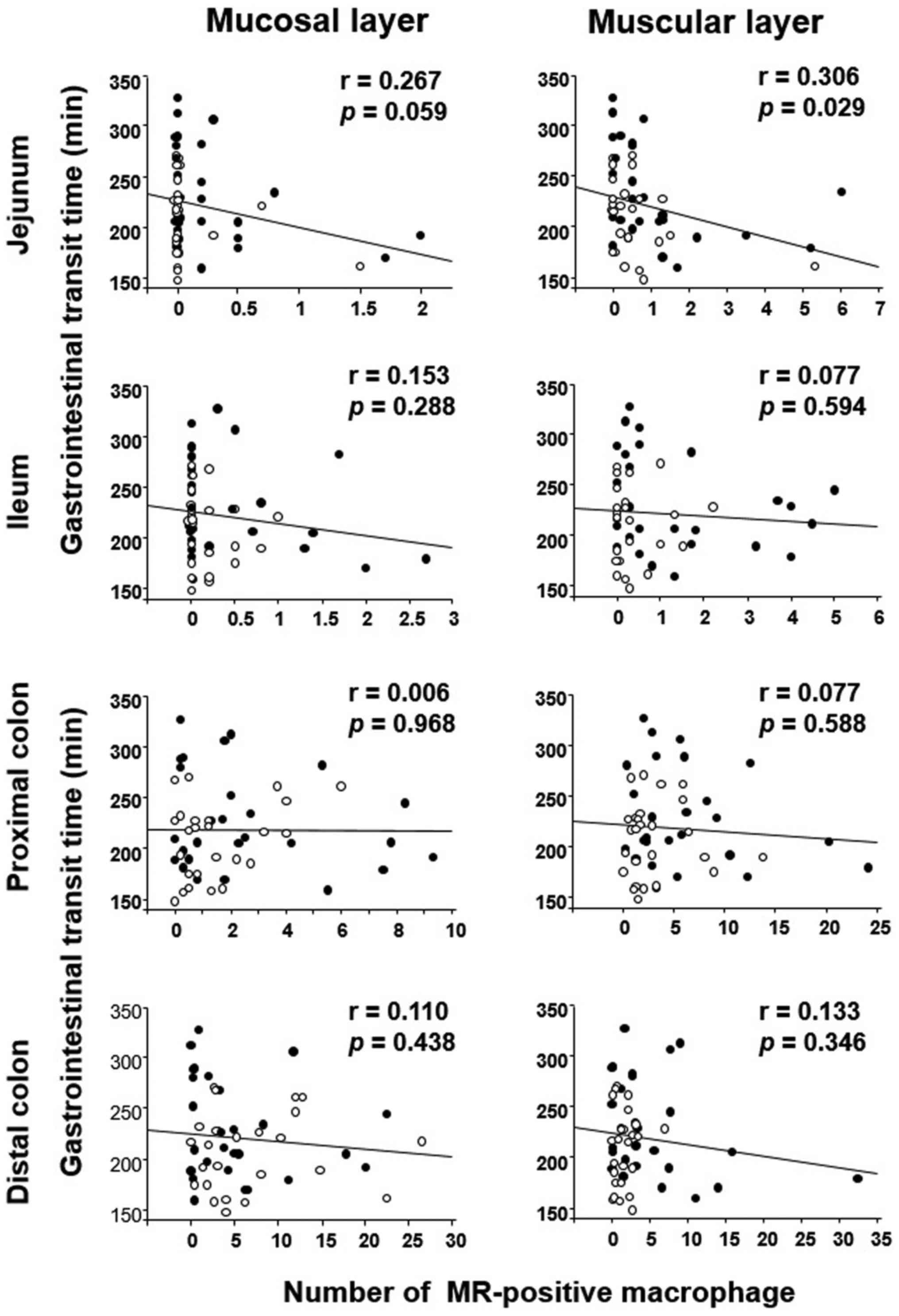|
1
|
Longstreth GF, Thompson WG, Chey WD,
Houghton LA, Mearin F and Spiller RC: Functional bowel disorders.
Gastroenterology. 130:1480–1491. 2006. View Article : Google Scholar : PubMed/NCBI
|
|
2
|
Enck P, Aziz Q, Barbara G, Farmer AD,
Fukudo S, Mayer EA, Niesler B, Quigley EM, Rajilić-Stojanović M,
Schemann M, et al: Irritable bowel syndrome. Nat Rev Dis Primers.
2:160142016. View Article : Google Scholar : PubMed/NCBI
|
|
3
|
DuPont AW: Post-infectious irritable bowel
syndrome. Curr Gastroenterol Rep. 9:378–384. 2007. View Article : Google Scholar : PubMed/NCBI
|
|
4
|
Beatty JK, Bhargava A and Buret AG:
Post-infectious irritable bowel syndrome: Mechanistic insights into
chronic disturbances following enteric infection. World J
Gastroenterol. 20:3976–3985. 2014. View Article : Google Scholar : PubMed/NCBI
|
|
5
|
Tomita T, Kato Y, Takimoto M, Yamasaki T,
Kondo T, Kono T, Tozawa K, Yokoyama Y, Ikehara H, Ohda Y, et al:
Prevalence of irritable bowel syndrome-like symptoms in Japanese
patients with inactive inflammatory bowel disease. J
Neurogastroenterol Motil. 22:661–669. 2016. View Article : Google Scholar : PubMed/NCBI
|
|
6
|
Törnblom H, Lindberg G, Nyberg B and
Veress B: Full-thickness biopsy of the jejunum reveals inflammation
and enteric neuropathy in irritable bowel syndrome.
Gastroenterology. 123:1972–1979. 2002. View Article : Google Scholar : PubMed/NCBI
|
|
7
|
Ford AC and Talley NJ: Mucosal
inflammation as a potential etiological factor in irritable bowel
syndrome: A systematic review. J Gastroenterol. 46:421–431. 2011.
View Article : Google Scholar : PubMed/NCBI
|
|
8
|
Wouters MM, Vicario M and Santos J: The
role of mast cells in functional GI disorders. Gut. 65:155–168.
2016. View Article : Google Scholar : PubMed/NCBI
|
|
9
|
Barbara G, Cremon C, Carini G, Bellacosa
L, Zecchi L, De Giorgio R, Corinaldesi R and Stanghellini V: The
immune system in irritable bowel syndrome. J Neurogastroenterol
Motil. 17:349–359. 2011. View Article : Google Scholar : PubMed/NCBI
|
|
10
|
Cipriani G, Gibbons SJ, Kashyap PC and
Farrugia G: Intrinsic gastrointestinal macrophages: Their phenotype
and role in gastrointestinal motility. Cell Mol Gastroenterol
Hepatol. 2:120–130.e1. 2016. View Article : Google Scholar : PubMed/NCBI
|
|
11
|
Shea-Donohue T, Notari L, Sun R and Zhao
A: Mechanisms of smooth muscle responses to inflammation.
Neurogastroenterol Motil. 24:802–811. 2012. View Article : Google Scholar : PubMed/NCBI
|
|
12
|
Türler A, Schwarz NT, Türler E, Kalff JC
and Bauer AJ: MCP-1 causes leukocyte recruitment and subsequently
endotoxemic ileus in rat. Am J Physiol Gastrointest Liver Physiol.
282:G145–G155. 2002. View Article : Google Scholar : PubMed/NCBI
|
|
13
|
Zhao A, Urban JF Jr, Anthony RM, Sun R,
Stiltz J, van Rooijen N, Wynn TA, Gause WC and Shea-Donohue T: Th2
cytokine-induced alterations in intestinal smooth muscle function
depend on alternatively activated macrophages. Gastroenterology.
135:217–225.e1. 2008. View Article : Google Scholar : PubMed/NCBI
|
|
14
|
Boyer J, Saint-Paul MC, Dadone B,
Patouraux S, Vivinus MH, Ouvrier D, Michiels JF, Piche T and Tulic
MK: Inflammatory cell distribution in colon mucosa as a new tool
for diagnosis of irritable bowel syndrome: A promising pilot study.
Neurogastroenterol Motil. 30:2018. View Article : Google Scholar : PubMed/NCBI
|
|
15
|
Chassaing B, Aitken JD, Malleshappa M and
Vijay-Kumar M: Dextran sulfate sodium (DSS)-induced colitis in
mice. Curr Protoc Immunol. 104:252014.PubMed/NCBI
|
|
16
|
Kitayama Y, Fukui H, Hara K, Eda H, Kodani
M, Yang M, Sun C, Yamagishi H, Tomita T, Oshima T, et al: Role of
regenerating gene i in claudin expression and barrier function in
the small intestine. Transl Res. 173:92–100. 2016. View Article : Google Scholar : PubMed/NCBI
|
|
17
|
Eda H, Fukui H, Uchiyama R, Kitayama Y,
Hara K, Yang M, Kodani M, Tomita T, Oshima T, Watari J, et al:
Effect of Helicobacter pylori infection on the link between GLP-1
expression and motility of the gastrointestinal tract. PLoS One.
12:e01772322017. View Article : Google Scholar : PubMed/NCBI
|
|
18
|
Mayer EA, Tillisch K and Gupta A:
Gut/brain axis and the microbiota. J Clin Invest. 125:926–938.
2015. View
Article : Google Scholar : PubMed/NCBI
|
|
19
|
Wood JD: Neuropathophysiology of
functional gastrointestinal disorders. World J Gastroenterol.
13:1313–1332. 2007. View Article : Google Scholar : PubMed/NCBI
|
|
20
|
Lakhan SE and Kirchgessner A:
Neuroinflammation in inflammatory bowel disease. J
Neuroinflammation. 7:372010. View Article : Google Scholar : PubMed/NCBI
|
|
21
|
Yang M, Fukui H, Eda H, Xu X, Kitayama Y,
Hara K, Kodani M, Tomita T, Oshima T, Watari J, et al: Involvement
of gut microbiota in association between GLP-1/GLP-1 receptor
expression and gastrointestinal motility. Am J Physiol Gastrointest
Liver Physiol. 312:G367–G373. 2017. View Article : Google Scholar : PubMed/NCBI
|
|
22
|
Canton J, Neculai D and Grinstein S:
Scavenger receptors in homeostasis and immunity. Nat Rev Immunol.
13:621–634. 2013. View
Article : Google Scholar : PubMed/NCBI
|
|
23
|
Novoselov VV, Sazonova MA, Ivanova EA and
Orekhov AN: Study of the activated macrophage transcriptome. Exp
Mol Pathol. 99:575–580. 2015. View Article : Google Scholar : PubMed/NCBI
|
|
24
|
Deng B, Wehling-Henricks M, Villalta SA,
Wang Y and Tidball JG: IL-10 triggers changes in macrophage
phenotype that promote muscle growth and regeneration. J Immunol.
189:3669–3680. 2012. View Article : Google Scholar : PubMed/NCBI
|
|
25
|
Chadwick VS, Chen W, Shu D, Paulus B,
Bethwaite P, Tie A and Wilson I: Activation of the mucosal immune
system in irritable bowel syndrome. Gastroenterology.
122:1778–1783. 2002. View Article : Google Scholar : PubMed/NCBI
|
|
26
|
Barbara G, Stanghellini V, De Giorgio R,
Cremon C, Cottrell GS, Santini D, Pasquinelli G, Morselli-Labate
AM, Grady EF, Bunnett NW, et al: Activated mast cells in proximity
to colonic nerves correlate with abdominal pain in irritable bowel
syndrome. Gastroenterology. 126:693–702. 2004. View Article : Google Scholar : PubMed/NCBI
|


















